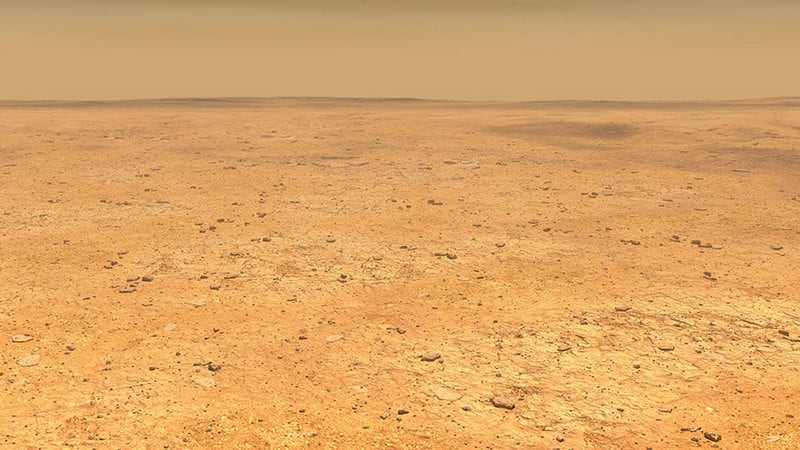- Home
- Science
- Science News
- NASA Wants People on Mars Within 25 Years
NASA Wants People on Mars Within 25 Years

Photo Credit: NASA/ JPL-Caltech
Deadly radiation from the cosmos, potential vision loss, and atrophying bones are just some of the challenges scientists must overcome before any future astronaut can set foot on Mars, experts and top NASA officials said Tuesday.
The US space agency believes it can put humans on the Red Planet within 25 years, but the technological and medical hurdles are immense.
"The cost of solving those means that under current budgets, or slightly expanded budgets, it's going to take about 25 years to solve those," said former NASA astronaut Tom Jones, who flew on four space shuttle missions before retiring in 2001.
"We need to get started now on certain key technologies," he told reporters in Washington.
At an average distance of about 140 million miles (225 million kilometres), Mars poses scientific problems an order of magnitude greater than anything encountered by the Apollo lunar missions.
With today's rocket technology, it would take an astronaut up to nine months to reach Mars -- the physical toll of floating that long in zero gravity would be huge.
For instance, scientists think prolonged weightlessness can cause irreversible changes to blood vessels in the retina, leading to vision degradation.
And after a while in zero G, the skeleton starts to leach calcium and bone mass.
With gravity only one-third of Earth's, scientists don't yet know the effects of a presumed one-year mission to the surface of Mars.
Better propulsion
One way to reduce wear and tear on the human body is to dramatically cut down on travel time to Mars.
Jones called for nuclear propulsion systems that would have the added benefit of producing electricity on flights.
"If we start now, in 25 years we might have these technologies available to help us and protect us from these long transit times," he said.
Under current conditions, just an outbound trip to Mars would take so long that any astronaut would receive the same amount of radiation than ordinarily would be deemed safe over the course of an entire career.
"We don't have the solution yet in terms of shielding, in terms of protecting you from cosmic rays and solar flares that you experience during this transit time," Jones said.
Aerospace experts have identified several technologies that need rapid development, including spacecraft that can survive the harsh entry into Mars and land softly enough, as well as the ability to lift people off the surface and head back to Earth.
NASA currently has a new robotic lander called InSight zooming towards Mars, due to land on November 26 after taking off from California on May 5.
The $993 million (roughly Rs. 7,160 crores) project aims to expand human knowledge of interior conditions on Mars, inform efforts to send explorers there, and reveal how rocky planets like the Earth formed billions of years ago.
Jim Garvin, Chief Scientist at the NASA Goddard Space Flight Center, said InSight would fill in "critical unknowns" and help build a key understanding of Mars.
In 2020, another mission will see NASA send a rover to Mars that aims to determine the habitability of the Martian environment, search for signs of ancient life, and assess natural resources and hazards for future human explorers.
Additionally, private firms like SpaceX and a host of other nations are building technologies that could be used on future Mars missions.
Some experts see new exploration of the Moon as key to a future mission to Mars, as astronauts there could learn about extracting water or using technology and apply those lessons to future Mars missions.
For the latest tech news and reviews, follow Gadgets 360 on X, Facebook, WhatsApp, Threads and Google News. For the latest videos on gadgets and tech, subscribe to our YouTube channel. If you want to know everything about top influencers, follow our in-house Who'sThat360 on Instagram and YouTube.
Related Stories
- Amazon Great Indian Festival 2024
- Big Billion Days 2024
- Apple Vision Pro
- Oneplus 12
- iPhone 14
- Apple iPhone 15
- OnePlus Nord CE 3 Lite 5G
- iPhone 13
- Xiaomi 14 Pro
- Oppo Find N3
- Tecno Spark Go (2023)
- Realme V30
- Best Phones Under 25000
- Samsung Galaxy S24 Series
- Cryptocurrency
- iQoo 12
- Samsung Galaxy S24 Ultra
- Giottus
- Samsung Galaxy Z Flip 5
- Apple 'Scary Fast'
- Housefull 5
- GoPro Hero 12 Black Review
- Invincible Season 2
- JioGlass
- HD Ready TV
- Laptop Under 50000
- Smartwatch Under 10000
- Latest Mobile Phones
- Compare Phones
- Realme Note 60x
- Honor X9c Smart
- Realme V60 Pro
- iQOO Neo 10
- iQOO Neo 10 Pro
- Redmi K80 Pro
- Redmi K80
- Lava Yuva 4
- Asus Zenbook S 14
- MacBook Pro 16-inch (M4 Max, 2024)
- Huawei MatePad Pro 13.2
- Oppo Pad 3
- Redmi Watch 5
- Huawei Watch Ultimate Design
- Sony 65 Inches Ultra HD (4K) LED Smart TV (KD-65X74L)
- TCL 55 Inches Ultra HD (4K) LED Smart TV (55C61B)
- Sony PlayStation 5 Pro
- Sony PlayStation 5 Slim Digital Edition
- Blue Star 1.5 Ton 3 Star Inverter Split AC (IC318DNUHC)
- Blue Star 1.5 Ton 3 Star Inverter Split AC (IA318VKU)

















